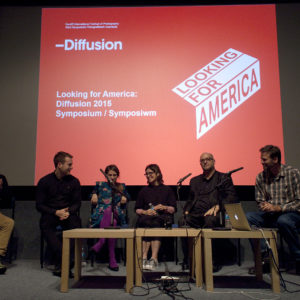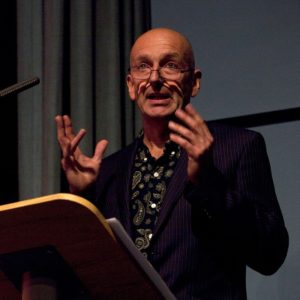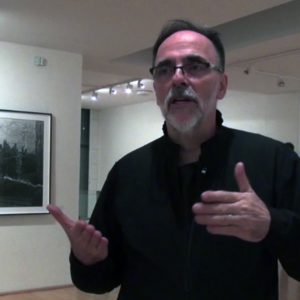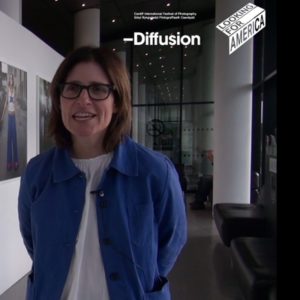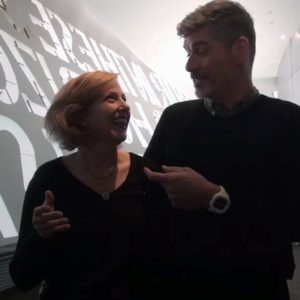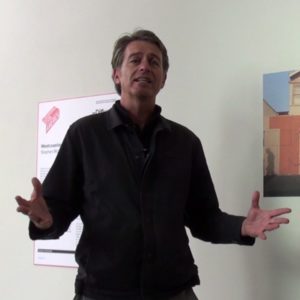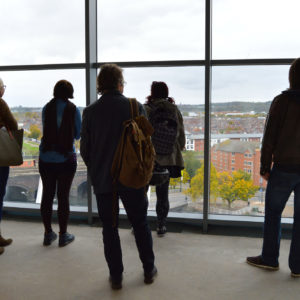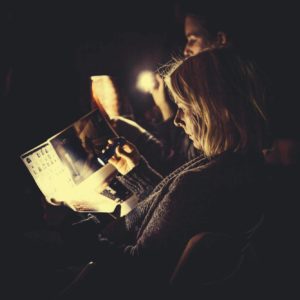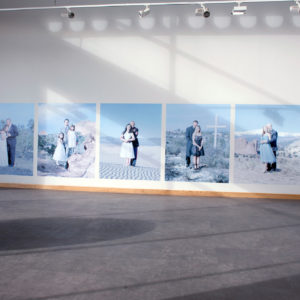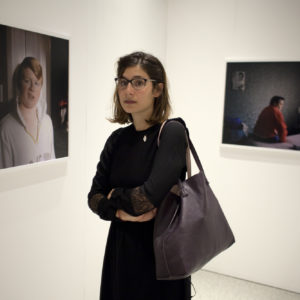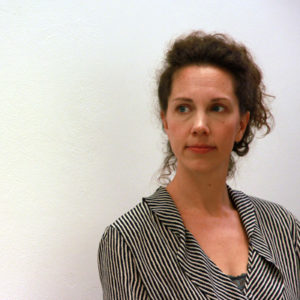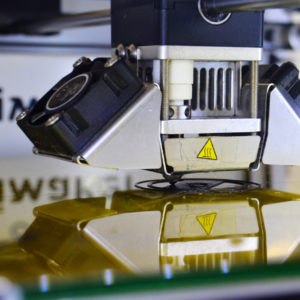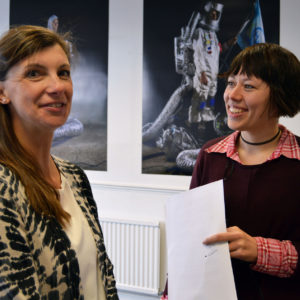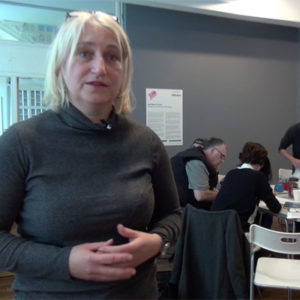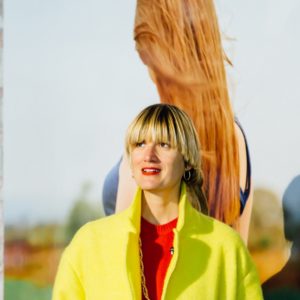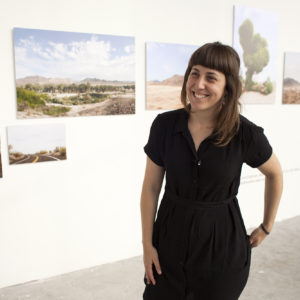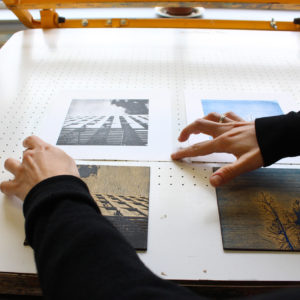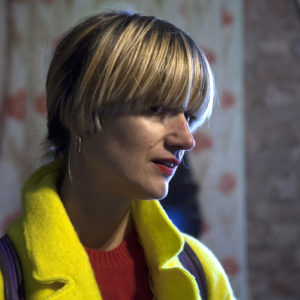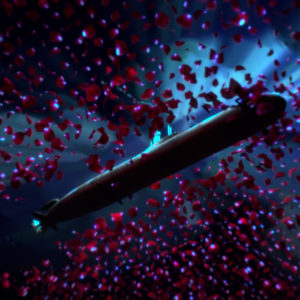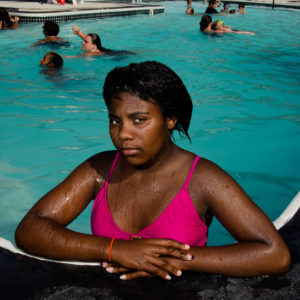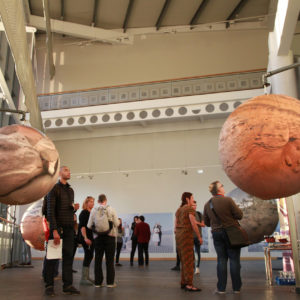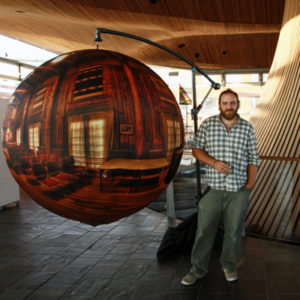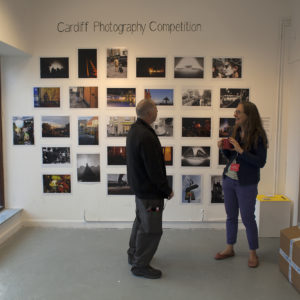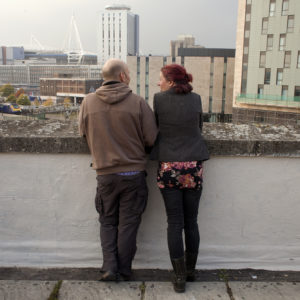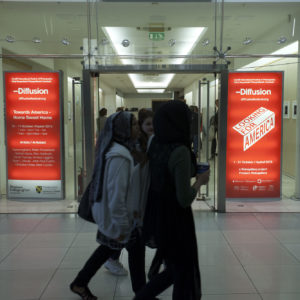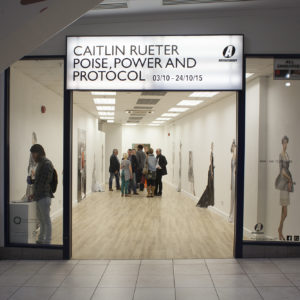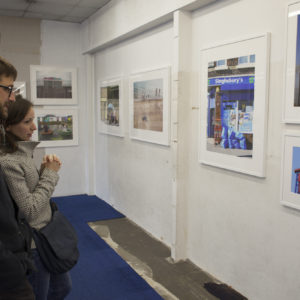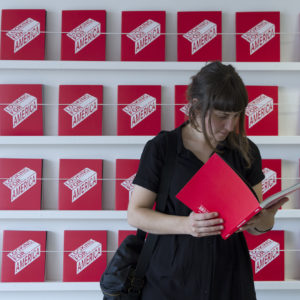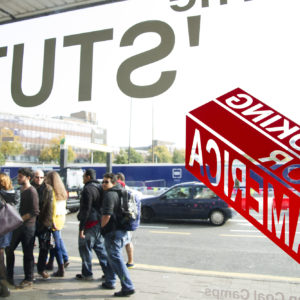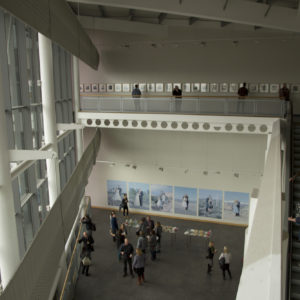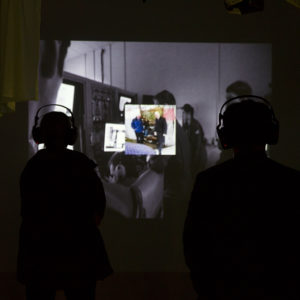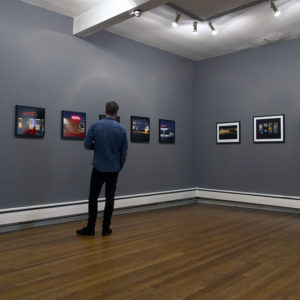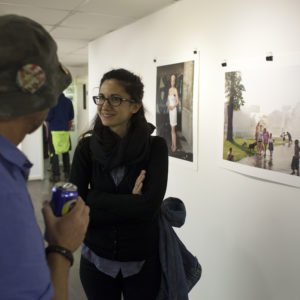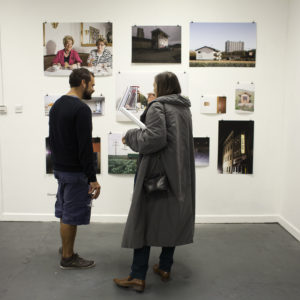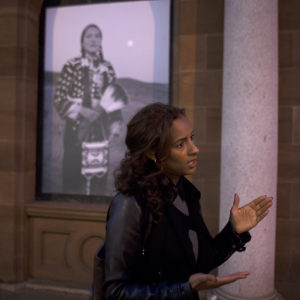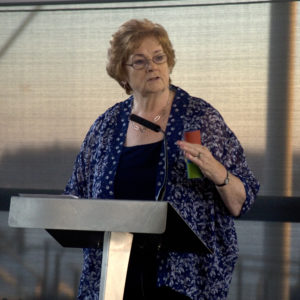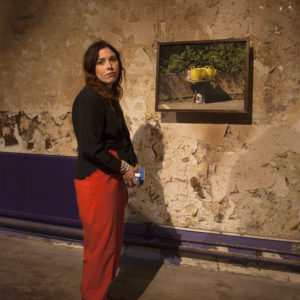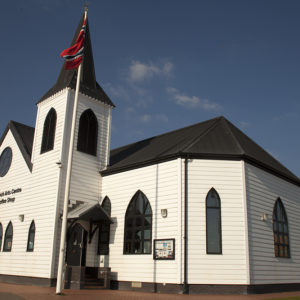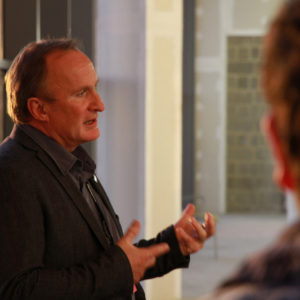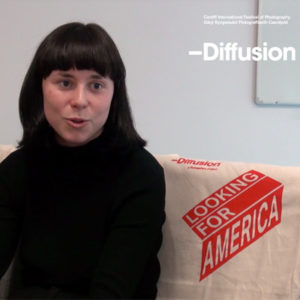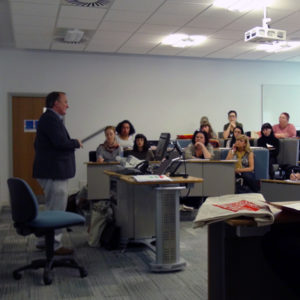re:diffusion
30 Oct Looking for America Symposium
Photography by Claire Kern
The very idea of America has come to be seen from abroad as a mythic power, symbolising deeply held aspirations, desires and fears. In America itself, the promise of increased prosperity and upward mobility has drawn millions there from around the world and fuelled rapid urban, economic and technological growth and the birth of a new consumer culture. America’s cultural influence overseas has been immense, with even the most remote corners of the world becoming new frontiers for the marketing of American music, food, sport, film, television and lifestyles.
However, in a post-9/11 world and period of widespread economic recession, the vaunted American Dream, the belief that life will get better, that progress is inevitable if we obey the rules and work hard, and that material prosperity is assured, has been replaced by a hard and bitter truth. Antipathy towards the United States' political and military involvement overseas, the toxic combination of corporate abuse, educational under-achievement, societal division and injustice, with the attendant economic meltdown, has tarnished America's national image and self-belief, perhaps irreparably.


























































Interview with Hillerbrand & Magsamen
Interview with Lisa Edgar Ffotogallery
Lisa Edgar introduces Julian Germain's Hidden Project commission at the opening in Customs House.
23 Oct The Camera & The Landscape
An exhibition tour with a difference. Rowan Lear drew out particular themes across the festival and presented an illustrated talk that placed each body of work in the context of photographic history and theory.
Photographs by Johanne Morgan




















22 Oct The Camera & The Dark
An exhibition tour with a difference. Rowan Lear drew out particular themes across the festival and presented an illustrated talk that placed each body of work in the context of photographic history and theory.
Photographs by Aga Hosking












21 Oct David Magnusson in The Guardian
This is not a freak show. These are portraits of girls and their fathers, shot on a large-format camera that picks up on the tiniest details: a hand clutching a finger; a fringe falling over one eye; sun reflected off a row of medals. Yet when David Magnusson’s images are published online, they prompt extreme reactions. “The internet is what it is,” the Swedish photographer tells BBC Culture. “Sometimes it’s great, sometimes it’s very quick and not that nuanced.” Challenging that kind of response is partly what inspired Magnusson to document young girls and their fathers as they took part in Purity Balls in Louisiana, Colorado and Arizona. “Many viewers are provoked by the images – some become very curious, ask everything about the project to try and understand the phenomenon, while others react strongly. It often tells you a lot about the viewer.” This image is part of his Purity project, currently being shown at the Diffusion Cardiff International Festival of Photography, and shows Jenna and Jeff Clark. The definition of ‘purity’ is broader than many think, according to Jeff: “Beyond our thoughts on sex we also are reminded that what we fill our minds with has a lot to do with how we live our lives. A pure heart, a pure mind and pure images in our mind help us to focus on the things in life that are most excellent. It allows us to make the most of our lives.”
Read the full article by Fiona Macdonald here.
Installation Photographs Michal Iwanowski






Interview with Clémentine Schneidermann
We asked Clémentine Schneidermann to tell us more about her project I called her Lisa Marie which captures Elvis fans in Tennessee and Wales.
Caitlin Rueter Interview
We caught up with Caitlin Rueter at the opening of Poise, Power and Protocol at Arcade Cardiff where she told us more about her exhibition.
17 Oct Fablab 3D Pinhole Workshop
Location: Cardiff Metropolitan University
Design and 3D print your own pinhole camera - participants learnt how to laser cut and use their pinhole camera at this workshop run by Cardiff School of Art and Design’s FabLab Cardiff.
Photographs by Beckie Jordan


















16 Oct The Camera & Family
An exhibition tour with a difference. Rowan Lear drew out particular themes across the festival and presented an illustrated talk that placed each body of work in the context of photographic history and theory.
Photographs by Johanne Morgan
























And Now It's Dark Activity Pack
Aimed at families and young people, the Diffusion Workbooks have been designed to promote understanding of and participation with the artworks. These packs are a mix of questions and activities that invite the users to consider their response to the exhibitions through their own words and images. This pack accompanies the group exhibition And Now It's Dark featuring work by Todd Hido, Jeff Brouws and Will Steacy.
Downloads
Interview with Zoe Partington
Artist Zoe Partington-Sollinger has created a series of 10 portraits which share her conversations with a collection of disabled artists from around the world about their notion of the ‘American Dream’. Turning it on Its Head uses sound and image to challenge traditional portraiture and provides a critical exploration of Zoe’s own experience of sight loss and her personal interpretation of images.
As part of the project she is inviting audiences to share their American Dream through photography or sounds which audiences can upload to the website. During the festival, Zoe is running introductory workshops to audio description and encouraging participants to create portraits with sound, photos and words influenced by ‘The American Dream’.
13 Oct Hidden Presence Talk at BayArt
13 October
Artist Eva Sajovic and the Ffotogallery Education team worked with groups of young people across South East Wales, looking at both the history and modern day implications of slavery and exploitation. In this talk Eva spoke about the project, and more widely about her practice, followed by a round table discussion on the impact of socially engaged practice, and where it sits in contemporary art in Wales.
Photographs by: Beckie Jordan, Tracey Paddison, Richard John Williams

















San Francisco 64 & A Pink Flamingo Activity Pack
Aimed at families and young people, the Diffusion Workbooks have been designed to promote understanding of and participation with the artworks. These packs are a mix of questions and activities that invite the users to consider their response to the exhibitions through their own words and images. This pack accompanies the exhibitions San Francisco 64 and A Pink Flamingo.
Downloads
Interview with Janire Najera
Moving Forward, Looking Back
Janire Nájera
Stadium Plaza
01 - 31 October
Moving Forward, Looking Back: Journeys Across the Old Spanish Trail is a documentary project focusing on identity, based on memory and inspired by travel.
Looking for the traces of intangible heritage that evokes Spanish culture in the American Southwest, photographer Janire Nájera drove along the Old Spanish Trail following in the footsteps of Antonio Armijo, who first opened this trade route in the 19th century. Moving Forward, Looking Back provides an insight into how the traditions of the first settlers have merged with local cultures and have influenced the identity of today’s pueblos and modern cities in the states of New Mexico and California.
Janire Nájera is a photojournalist based between Wales (UK) and Bilbao (Basque Country, Spain). Janire is concerned with highlighting communities around the globe which have been displaced through changing social and economic climates, with the aim to rethink and develop our understanding of the environments we belong to.
10 Oct Fablab Woodblock Print Photography Workshop
Location: Cardiff Metropolitan University
Traditional printmaking techniques met digital technology at this workshop run by Cardiff School of Art and Design’s FabLab Cardiff on 10 October 2015.
Participants brought along a favourite photo on a memory stick (jpg format), and learnt how to manipulate it using open source software, laser cut the image onto a wooden printing block and use it to make a series of prints.
Photographs by Sybilla Britani











Interview with Eva Sajovic
The Hidden Presence exhibition is the culmination of a two-year engagement project from Ffotogallery Education, Chepstow Museum, and artists Eva Sajovic and Julian Germain.
George Barber Q&A in AN Magazine
A Q&A with… George Barber, video artist
George Barber is best known for his pioneering ‘scratch video’ work in the 1980s, which tapped into the new MTV aesthetic of the time, with fast-moving video cut-ups of Hollywood films and TV advertising.
Born in Guyana and based in London, Barber has since developed a large and varied body of film-based work that includes performative monologues, narrative films and conceptual work such as Automotive Action Painting (2007) and Shouting Match (2004-2011).
The latter is typical of Barber’s at-a-tangent way of looking at the world and the people in it. Filmed in four locations – London, Tel Aviv, Bangalore and New Orleans – the piece explores different cultures through the medium of shouting. Noisy, chaotic and a bit bonkers, all four films are brought together for the first time in a large solo exhibition at Chapter, Cardiff, which forms part of this year’s Diffusion festival of photography.
One new piece showing in Cardiff, Fences Make Senses (2015), is also featured in a small show at Waterside Contemporary, London and touches a very topical nerve in its examination of the global refugee crisis. Says Barber: “The central theme is: ‘Imagine swimming to a place you’re not wanted’.”
Your new film, Fences Make Senses, deals with the refugee issue in a sometimes absurd and darkly humorous way. What prompted you to make it?
The work responded to a moment in 2014 when I’d been to a lot of film festivals and I kept seeing the same work; these appalling interviews with refugees talking about their terrible experience and losing everything. Art can’t really take on events of such immensity – in that sense it’s very difficult to make a work about, say, 9/11, which is still cascading on and its influence is still there. So I knew I couldn’t offer any solution but I wanted to bring it home. The idea was that I would get my friends or people I knew to actually rehearse some of the scenarios that these people faced, like buying a boat or having all your money taken off you or dealing with bureaucracy. There’s a lot of absurdity in these situations and the rehearsals point out the absurdity, but they’re also tragic as well. The trouble is that when people are in dire straits they’ll believe anything.
How important is humour in the work?
I didn’t start with the idea of being humorous. I saw all these films about this crisis and they shared a certain approach – in a way they aestheticise the issue, like Bob Geldof did with Live Aid, an endless stream of crying children with flies on their faces. It becomes so abstract that they just become images and then you get a credit card number to call. The films I was seeing seemed the same – they did make you feel terrible but again there was no sense of being inside it or thinking a bit more about it. In some ways they just add to the confusion. My piece was attempting to do something different.
When it comes to something like a world refugee crisis, what role can art play?
An artistic response is just as valid as a journalistic response, but let’s get it straight – art probably doesn’t affect anything. If you took Guernica, for example, we remember it because of that Picasso painting; if we hadn’t had the painting we probably wouldn’t know it so well. And there are various events historically that live on because of an art piece. But I don’t think any piece of art has ever changed a politician’s viewpoint. So I don’t think that artists have that much power to change the world or affect politics, but obviously they’re part of a stream and as viewpoints change they’re part of that. And secondly, as an artist one just has to follow one’s heart if you get an idea.Your piece, The Freestone Drone (2013), also looks at a very topical subject by giving a voice and personality to a military drone.
You take from what you see around you, and with drones I noticed that what people were particularly fearful of, the thing that made them shudder, was this idea of a young man or woman who spends all day in Portacabin looking at screens, taking out people, and then gets into the same commuter flow as you and goes home. And what revolts people is that they’re not facing any danger themselves. Of course these arguments were used with aeroplanes, carpet bombing, tanks – there’s a long tradition of this kind of response [to new methods of war]. So the idea in the film is to make the drone a child that is just starting to realise what he does – in a way, it is gaining consciousness. Some of the lines, if you’re a little bit superficial, might seem silly, but in fact when the drone says “People don’t seem to like me, I’m a bit creepy, could I ever be a nice drone?” and then there’s this lush classical music – I think it’s quite moving.
So the piece isn’t so much a critique of this new means of destruction as a critique of our response to them?
It’s a response to drones – and artists like anyone else have a right to express how they feel about drones and of course it’s not going to come out like a classic text in The Economist. With me, it’s going to come out as trying to put connections and ideas that actually then represent it in a way that makes you think about it differently. I don’t think you any more understand it; I read the factual stuff and then it comes out in different ways. The feel of the film owes something to Chris Marker/Godard – I spent a lot of time as a student watching Godard films. The drone says at one point: “I can see images of the present, they’re in the past.” And actually the same things keep coming up in the news; war is much the same, it’s the same old thing, makes no sense – it’s really about human beings and territory.
The title of your show at Chapter, Cardiff – Akula Dream – is also the title of another rather absurdist recent film, this time set on a Russian nuclear submarine.
I don’t think I’ve exhausted this idea of using technology or a machine as a way into a subject. So when I finished The Freestone Drone it seemed to open up the whole possibility of other things, and I liked this idea that for a nuclear submarine to be a deterrent you have to hide and that means being quiet. So it’s I like this kind of monastery, all these men sitting around in the boat, but in Akula Dream(2015) the captain gets sick of it and he wants to start holding hands and having seances and trying to help the world with thought power and shamanic drumming. Again, it has a comedy to it, but it’s also quite profound. “The world is calling us, we need to answer it,” says the captain, and I like the idea that these people aren’t going anywhere they’re just sitting in silence, but in a sense they’re calling out and travelling the world in different plains, they’re reaching out, they’re thinking outside the box. It’s about a war machine that gets converted to a vehicle of love – it’s a bit like The Beatles’ Yellow Submarine! It’s my version
Ffotomatic Interview
Ffotogallery have teamed up with I Loves the Diff to bring photography to the people of Cardiff by repurposing vending machines to sell Diffusion prints and souvenirs. Find out more about the project.
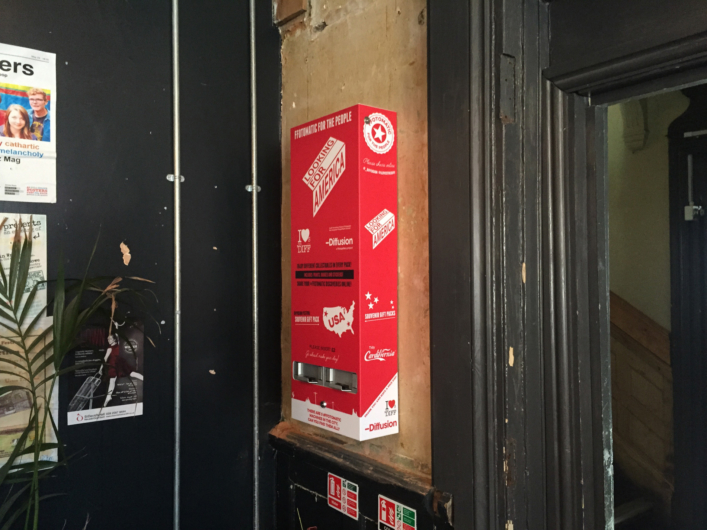
9 Oct Stacy Kranitz in The Guardian
Can a photostory on the Appalachians shuck the hillbilly stereotype?
Back in 2012, Stacy Kranitz’s photographs of Appalachia caused a storm online when a selection of them were published by CNN. One of the more thoughtful responses to the furore came from Roger May, a documentary photographer and “proud Appalachian”.
“After spending some time on [Kranitz’s] site,” he wrote on his blog Walk Your Camera, “I began to notice a sort of pattern CNN must have used when selecting photos ... They skipped over image after image of ‘everyday lives of the people of Appalachia’ and settled instead for the most common stereotypical images from our collective darkest preconceptions of this region. In short, they perpetuated the visual myth of Appalachia. The KKK and strippers?”
Indeed, CNN chose 16 shots from the 77 in the opening section of Kranitz’s Appalachian series and, in doing so, had distorted its complex dynamic. “I am stunned that they would take my work out of context,” Kranitz said at the time, pointing out that her series was not about the “everyday lives of Appalachian people”, but was instead a wilfully edgy exploration of Appalachian stereotypes.
“I sought out the stereotypes and photographed them so I could then offer a counter,” she wrote. “That is what the project is about. It is meant to be a dialogue about stereotypes: the mythology they create, their value and their role in society.”
Three years on, the Appalachian series, now called As it Was Give(n) to Me, is one of the highlights of Diffusion: Cardiff international festival of photography. Alongside her own arresting shots of the region and its often hard-living residents, Kranitz has used found images and texts including biblical quotations, an archive of local superstitions and confessional notes from a weekly reader’s column called Speak Your Piece in the Mountain Eagle newspaper of Letcher County, Kentucky. One such note reads: “I am 14 years old and my mom dumped me because her boyfriend said he didn’t want me around and she blames it on me. I know you hate me, Mom. You never believed me. I thought you loved me, but you love the new house, phone and dog better.”
“I wanted to figure out a way to highlight the discovery process, how one comes to understand a place through different source materials,” says Kranitz, who was raised in Kentucky but now lives in Los Angeles. “So, the exhibition functions as a personal archive of my experiences.”
She works, she admits, in a “very compulsive manner” – immersing herself in the lives of her subjects and occasionally putting herself at risk. Kranitz has written ofa drink-fuelled mountain ride on an ATV (all-terrain vehicle) with a guy called Dozer that ended with it crashing and rolling in the dark. She escaped with only bruises, and was given “a crushed up Lortab [an opioid painkiller] to snort for the pain.”
She is now five years into her immersive Appalachian project. “I like to live out of my car as long as I can,” she tells me. “I begin to slowly deteriorate the longer I do this. It sounds bad, but this is what I want. I believe that I am not making good work unless I am pushing myself into a very uncomfortable place. There is a part of me that thinks there is value in pushing myself to the brink of my own sanity. I’m not sure this is true, but it’s how I have made the work.”
Sailing close to the stereotypes is her methodology, then. “I’m not filled with a noble desire to show the world a certain type of injustice in hopes of remedying it,” she says.
Kranitz’s shots, however confrontational, have a raw energy that is often fractured by thoughtful moments. Poverty, drug and alcohol abuse and machismo are all on display, but so is the beauty of the place and the spirit of its people. “At some moments my experiences completely defy what we know about the region,” she says, “and at others, they dig into and reaffirm the most obvious stereotypes. I don’t want to reinforce mass media’s one-dimensional view of Appalachia as a poverty-ridden region. But I also don’t believe I’m serving the people by making propaganda that ignores the poverty.
It strikes me that it’s much harder to illuminate the everyday lives that define a place than the extreme ones that we – as image makers and image consumers – are vicariously drawn to.
Read the full article by Sean O'Hagan here







Trigger Questions
A downloadable resource for schools and colleges featuring a selection of Diffusion exhibition images. The Ffotogallery Education Team have thought of number of questions to help trigger discussions about the themes and narratives in the photographs.
Downloads
8 Oct Arthur Tress Reception for Iris Prize
IRIS PRIZE TEAMED UP WITH DIFFUSION, CARDIFF'S INTERNATIONAL PHOTOGRAPHY FESTIVAL, TO PROVIDE A SPECIAL RECEPTION AND PRIVATE VIEW OF ARTHUR TRESS' EXHIBITION 'SAN FRANCISCO '64' AT STADIUM PLAZA.
Arthur Tress was born on November 24, 1940, in Brooklyn, New York.
His early photographic experiments were deeply influenced by Heinrich Bluecher of Bard College, New York, with whom he studied comparative world culture and philosophy. In 1962 Tress went to Paris to study filmmaking but soon gave it up. Over the next several years he travelled through Europe, Africa, Mexico, India, and Japan. His photography shifted towards ethnographic documentation of the different cultures. In 1967 Tress moved to Sweden where he prepared educational filmstrips for the Stockholm Ethnographical Museum. Here he began in earnest a distinct directorial style of documentation, employing candid situations altered to suit his particular and intuitive imagination. In 1968 he moved back to New York with a commitment to becoming a professional photographer.
Jury members, filmmakers and friends of Iris were invited to a drinks reception in the exhibition space, followed by a walk and talk by Ffotogallery director David Drake and a speech by Iris Prize director Berwyn Rowlands.
Speaking of the new partnership, Berwyn focused on how much both festivals have in common, saying “as a small country like Wales matures, it looks outwards as well as inwards to nurture creativity. This outlook is something that Iris and Diffusion: Looking for America very much have in common”.
Photographs: Anne Siegel





















Interview with Matt Wright
During the opening of Diffusion 2015 at the Senedd in Cardiff Bay, we caught up with Matt Wright whose Exhibition Southwestern Reflections was part of the opening in the Senedd. We asked Matt all about his exhibition and how it came about.
3rd Oct Cardiff Pride of Place Opening at Abacus
Caravan Gallery - Cardiff Pride of Place Project
The Caravan Gallery
The Abacus
1-31 October
Photographs by Claire Kern



































3rd Oct The Capitol Centre






















3rd Oct Arcade Cardiff Opening
Poise, Power, and Protocol
Caitlin Rueter
Arcade Cardiff
03 - 23 October
Photographs by Anne Siegel & Claire Kern




















8 Oct Diffusion in British Journal of Photography
Diffusion, Cardiff's premier photography festival is back for its second edition, and this year is looking to America for inspiration
Diffusion, the international photography biennale organised by Cardiff’s Ffotogallery is currently in full swing, hosting group shows, talks and photography-related events around the city for the entire month of October.
The theme, Looking for America, was announced back in May 2013, on the last day of the previous edition. Despite the continuous barrage of American imagery, David Drake (director of Ffotogallery and curator of the festival) says that the theme is as pertinent as ever.
“I was interested in the strange paradox that from outside of America there was still an allure around Americana and a lot of the things that become representative of the American Dream. But within America there was a sense of corrosion, that everything had gone wrong.
The inside perspective on America was quite dark and dystopian whereas from a European perspective America was still the promised land, a land of opportunity. I thought that we could have quite a lot of fun exploring those notions through the festival.”
The festival spans several sites around the city, in an effort to engage both serious photography lovers and a broader audience. The empty storefronts on Wood Street, a central area earmarked for regeneration have been repurposed into accessible gallery spaces.
The Abacus art space has been taken over by The Caravan Gallery, the mobile exhibition venue and visual arts project run by artists Jan Williams and Chris Teasdale. Constantly grappling with what they call “local distinctiveness and regional identity” with a mischievous sense of the surreal, they’ve set up an “art exhibition-cum-alternative visitor information centre” to explore the many facets of Cardiff.
Also on Wood Street is As It was Give(n) to Me, Stacy Kranitz’s installation exploring the former mining communities of Appalachia. The hard-edged images are leavened by historical maps, folk artefacts and found objects that allow for a more textured expression of post-industrial decline.
A couple of doors down is Roger Tiley’s own, softer black-and-white images of these communities. This bridge between Kranitz and Tiley, known for his work documenting Welsh coal mines, is a prime example of the vein of dialogue between Wales and America that Drake hopes runs through the exhibition.
“Looking at the experience of people in the former mining community of Appalachia and that of people in South Wales, you could find similar images – though perhaps the Welsh pictures have more people getting drunk and maybe different drugs… The impact of the closure of the mines on communities and the lack of prospects, the fact that in South Wales there is 35% unemployment… it parallels what’s going on in Appalachia.”
Similarly, Ken Griffith’s Patagonia delineates a shared culture between Wales and the Americas in a small pocket straddling Chile and Argentina. The New Zealander documented his expeditions to Chubut, Patagonia to follow in the footsteps of the Welsh settlers of the late 1800s who ventured to South America in search of a land where they could preserve their culture and language.
Stadium Plaza, a retail and leisure quarter replete with a Vue cinema and a bowling alley is another unexpected venue for Diffusion to sneak work into. While Vue punters queue at the concession stand, they’ll catch a glimpse of the raw, unvarnished images of California from Stephen McClaren’s Westcoastism. David Magnusson’s portraits of young girls from Louisiana, Colorado and Arizona who have taken purity vows with their fathers have been blown up to size, looming over the view of the River Taff. The curious can venture further to find work by the likes of Jack Latham, Janire Nájera, and Arthur Tress.
“A lot of the work seems to be about the construction of the American identity,” Drake comments, and the work sited in the Wales Millennium Centre is a particularly apt example of this. You’ll find two contrasting projects from Jona Frank; High School, a layered set of portraits exploring the tribal cliques and personalities that are tried on for size during these years, and Right, where she photographed students of a staunchly Republican Christian private school.
Clementine Schneidermann’s I Called her Lisa-Marie confirms that the Elvis legend is alive and well – from Memphis to Porthcawl, where an annual festival is held honouring the King. You’re never entirely sure whether the images are from Tennessee or South Wales, and as Drake says, “them becoming Elvis or surrounding themselves with memorablilia was a way people who’ve had quite tough lives, whether that be in South Wales or in Memphis, could transcend that through the glitter and kitsch of the Elvis phenomenon.”
Ffotogallery’s own space plays host to ‘And Now It’s Dark’, gathering the work of American heavyweights Jeff Brouws, Todd Hido and Will Steacy. Presenting an ambiguous vision of nocturnal American cities, the work highlights the revelatory effect of the presence of light in darkened spaces. Brouws and Steacy’s work points toward the underlying decay of the American city, made visible at night under brightly-lit neon signs. Hido’s photographs are more suburban and hint at the latent dangers and perhaps, pleasures of the night.
Besides the work being exhibited, the festival is running a number of photography-related events suitable for all audiences. Book launches and symposiums cater to the faithful, educational talks and workshops allow children to get involved and portfolio reviews offer the chance for young photographers to get their work seen by notable curators and professionals.
Wales is becoming something of a magnet for British and European photography students, with the acclaimed Documentary Photography course at University of Wales, Newport joined by flourishing institutions such as Trinity St David Swansea and Aberystwyth University. For Drake, Wales has always been a natural venue for photography.
“Photography has played a role in Wales since its invention in the 1830s when William Henry Fox Talbot made some of the world’s earliest photographs in and around Swansea and Margam. Eugene Smith, Philip Jones-Griffiths and Robert Frank’s images of the South Wales Valleys provide some of the most iconic representations of coal mining communities. That legacy perhaps explains the enduring interest Welsh audiences have in photographic images – both contemporary and historical.”
America, both as an idea and as a site for images, is perhaps overrepresented in the cultural sphere and at first glance is an odd fit for a Cardiff festival, but Drake disagrees:
“I did a project on Dylan Thomas’s time in New York last year and I realised there’s something about Welsh writers, artists, musicians etc. where they look West [to America]. It was true of Thomas, of John Cale when he went off and joined the Velvet Underground, and of W.H. Davies [the writer who spent time in 1890s America living as a hobo]. It’s not an accident that they end up in New York or Pennsylvania rather than Paris or London.”
Richard Burton and Elizabeth Taylor notwithstanding, Wales and America are unlikely cultural bedfellows. While this bond between 3 million and 300 million is not the most prominent or prized relationship either nation has, with work from the likes of Julian Germain, Arthur Tress and Melissa Moore on show, Diffusion hopes to inspire audiences to look a bit closer.
Read the full article by Brennavan Sritharan here
3rd Oct The Stute Opening
Appalachian Coal Camps, Roger Tiley, 01 - 31 October
Land Ends, Melissa Moore, 01 - 31 October
Stateside, Matt Wilson, 01 - 31 October
This is Not My Beautiful House, Marc Arkless, 01 - 31 October
Photographs by Claire Kern & Anne Siegel



































3rd Oct Stadium Plaza Openings
Exhibitions:
Moving Forward Looking Back, Janire Nájera, 01 - 31 October
Purity David Magnusson, 01 - 31 October
San Francisco ‘64, Arthur Tress, 01 - 31 October
A Pink Flamingo, Jack Latham, 01 - 31 October
Westcoastism, Stephen McLaren, 01 - 31 October
Soutwestern Reflections, Matt Wright, 01 - 31 October
Photographs by Anne Siegel & Claire Kern








2nd Oct Chapter Opening
































2nd Oct Ffotogallery Opening
And Now it's Dark
Will Steacy, Todd Hido, Jeff Brouws
Ffotogallery
01 - 31 October
Photographs by Anne Siegel & Claire Kern














1st Oct Third Floor Gallery Opening












1st Oct Cory's Tale of Two Cities Opening
































1st Oct BayArt & Merchant Place Opening
Dépaysé
Serge Clement
BayArt
02 - 31 October
America
Delphine Diallo
Merchant Place
01 - 31 October
Photographs by Claire Kern
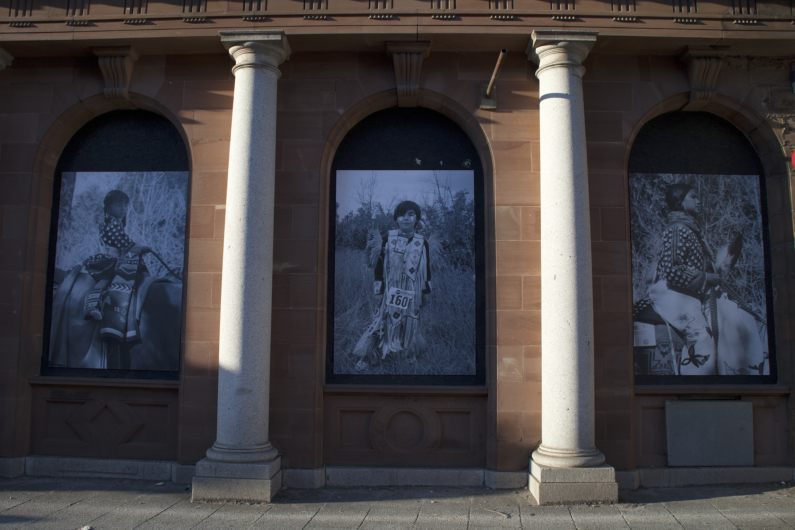
1st Oct Official Festival Opening at the Senedd
We hosted our opening ceremony at the Senedd building in Cardiff Bay with speeches by Dame Rosemary Butler, David Alston and David Drake.
Photographs by Claire Kern.






























1st Oct Hidden Presence Opening at Customs House
Hidden Presence
Eva Sajovic, Julian Germain
Customs House
01 - 31 October
Photographs by Claire Kern & Tracey Paddison


















1st Oct 2015 - Norwegian Church Opening
Patagonia
Ken Griffiths
Norwegian Church Arts Centre
01 - 24 October
Photographs by Claire Kern
In the early 2000s, Ken Griffiths undertook three expeditions to Chubut in Patagonia, accompanied on those journeys by his friend Norman Thomas di Giovanni, a writer, onetime resident of Argentina, and translator of their most famous writer, Jorge Luis Borges. Griffiths and di Giovanni were from the outset moved by the quest of the Welsh settlers who set out from Liverpool in search of a South American home where they could preserve their culture and language. Nearly defeated in the first year by hardship and starvation, they succeeded through inexhaustible determination and their enlightened treatment of the native Indians, the Tehuelche, who made annual migrations to the area. Griffiths and di Giovanni were fascinated by the achievements of these ordinary Welsh settlers, spearheading a route to the Andes and forming a new colony there that is now part of the mythic lore of Argentina.
The artists studied scores of early photographs by John Murray Thomas, one of the colony’s founding fathers, and retraced the routes of the Welsh early pioneers.
The exhibition coincides with the 150th Anniversary of Wales-Patagonia.









1st Oct WMC Openings
I Called her Lisa-Marie
Clementine Schneidermann
Wales Millennium Centre
01 - 31 October
High School/Right
Jona Frank
Wales Millennium Centre
01 - 31 October
Photographs by Claire Kern











I-D interview with Diffusion Festival Director
The second edition of the Cardiff International Festival of Photography opens up for the month of October, taking over the city's galleries, bus stops and bowling alleys with imagery that grapples with the American landscape, culture and spirit. This year's Looking for America theme sees more than 30 renowned photographers looking at wilderness and community, cars and bars, suburbanites and outlaws. As well as celebrations of American life, there are inevitably questioning and dystopian images in the mix too. Jeff Brouws, Todd Hido, Will Steacy, Stacy Kranitz and David Magnusson are some of the big names chosen Festival Director David Drake, whose Welsh mother and Detroit father put him in an ideal place to assess the USA from Wales's cultural centre.
Why did you choose America as this year's theme?
I was quite interested in the idea of America because it's culturally such a strong reference point for so many things: movies, advertising, music, photography. You don't have to go to America to buy into that. There's something about the endless highway and the endless opportunity and the allure of Americana.
I see that you try and connect some of the work to Europe, more specifically Wales.
I thought it would be interesting to foreground what was actually happening in America and get the perspective from within, which is why Todd Hido, Will Steacy and Stacy Kranitz are involved. But I also want to present the view of America from Europe, so am showing Clémentine Schneidermann's work, which was photographed in South Wales and Memphis; both places there were people who weren't materially that well-off, or that happy, but were embracing the Elvis dream, helping them transcend their everyday existence.
If you're "Looking for America", what have you found?
Some of the work is very dystopian, and America is a very scary place in a lot of the pictures. Todd Hido has a David Lynch, Blue Velvet side to it. I also got introduced to Arthur Tress and the San Francisco '64 series of his seemed pertinent as well. That was called "the last year of innocence" in America. Martin Luther King had just won an award for his work for the civil rights movement, Kennedy had been assassinated, the Vietnam War was kicking off and The Beatles made their first trip to America. It captured one of those moments when American values, as they had been in the 1950s, were being challenged in the 60s. When I choose a historical show like that, it's because I want it to have a contemporary resonance.
You're showing the images in shopping malls, bus stations, bowling alleys and a customs house, as well as galleries. How come?
People like to encounter contemporary photography and art in unusual spaces. They like the dialogue between the work and the space it's shown in.
Which photographer really stands out for you this year?
Stacy Kranitz's project that we're showing, As It was Give(n) to Me, is really interesting. She's from Kentucky, so she's been making this work about a former mining community in trouble. There's a crystal meth problem, lap-dancing, people spiralling out control, but she also combines that with historical maps, documents, dolls and artefacts. It's beautifully installed. Those same problems of alcoholism and substance abuse are also quite prevalent in the old mining communities in Wales. There are some pretty punchy images in there.
How do you avoid covering the more obvious style of American photography and portrayal?
Sometimes it gets to the point when if you see another sub-Ansel Adams American landscape or desert road with tumbleweed, it makes me want to reach for my gun. A lot of people are trying to remake those classic photographs. They might well sell them in Santa Fe or wherever, but it's a pretty pointless thing to be doing. Whereas Matt Wilson working with expired film, coming up with these very poetic images that hint at a narrative, but don't spell it out in a literal way, is much more exciting. There is an issue with documentary photography - a lot of stuff looks quite similar, whether you're in Helsinki, Amsterdam, New York. There is a language of documentary photography. Some of the artists I've featured, might not be the greatest photographers in their genre, but they have something more interesting to say. It's whether the idea and the execution of the idea all comes together.
Read the full Article by Stuart Brumfitt here
Interview with volunteer Hannah Saunders
On the 25th of September we held our volunteer induction day. We interviewed Hannah Saunders about why she is volunteering at this year's Diffusion Festival.
Volunteer Induction 25 Sep 2015
On the 25th of September we held our volunteer induction day at Cardiff Metropolitan University.





Higher Ground Activity Pack
Aimed at families and young people, the Diffusion Workbooks have been designed to promote understanding of and participation with the artworks. These packs are a mix of questions and activities that invite the users to consider their response to the exhibitions through their own words and images. This pack accompanies the exhibition Higher Ground by Hillerbrand and Magsamen.
